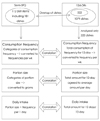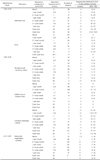1. Willet W. Nutritional Epidemiology. 1998. Second ed. Oxford University.
2. Vandevijvere S, De Vriese S, Huybrechts I, Moreau M, Temme E, De Henauw S, De Backer G, Kornitzer M, Leveque A, Van Oyen H. The gap between food-based dietary guidelines and usual food consumption in Belgium, 2004. Public Health Nutr. 2009. 12(3):423–431.

3. Dumartheray EW, Krieg MA, Cornuz J, Whittamore DR, Lovell DP, Burckhardt P, Lanham-New SA. Validation and reproducibility of a semi-quantitative Food Frequency Questionnaire for use in elderly Swiss women. J Hum Nutr Diet. 2006. 19(5):321–330.

4. Kim YO, Kim MK, Lee SA, Yoon YM, Sasaki S. A study testing the usefulness of a dish-based food-frequency questionnaire developed for epidemiological studies in Korea. Br J Nutr. 2009. 101(8):1218–1227.

5. Ovaskainen ML, Paturi M, Reinivuo H, Hannila ML, Sinkko H, Lehtisalo J, Pynnonen-Polari O, Mannisto S. Accuracy in the estimation of food servings against the portions in food photographs. Eur J Clin Nutr. 2008. 62(5):674–681.

6. Tokudome Y, Kuriki K, Imaeda N, Ikeda M, Nagaya T, Fujiwara N, Sato J, Goto C, Kikuchi S, Maki S, Tokudome S. Seasonal variation in consumption and plasma concentrations of fatty acids in Japanese female dietitians. Eur J Epidemiol. 2003. 18(10):945–953.

7. Tokudome Y, Imaeda N, Nagaya T, Ikeda M, Fujiwara N, Sato J, Kuriki K, Kikuchi S, Maki S, Tokudome S. Daily, weekly, seasonal, within- and between-individual variation in nutrient intake according to four season consecutive 7 day weighed diet records in Japanese female dietitians. J Epidemiol. 2002. 12(2):85–92.

8. Ahn Y, Kwon E, Shim JE, Park MK, Joo Y, Kimm K, Park C, Kim DH. Validation and reproducibility of food frequency questionnaire for Korean genome epidemiologic study. Eur J Clin Nutr. 2007. 61(12):1435–1441.

9. Barclay AW, Flood VM, Brand-Miller JC, Mitchell P. Validity of carbohydrate, glycaemic index and glycaemic load data obtained using a semi-quantitative food-frequency questionnaire. Public Health Nutr. 2008. 11(6):573–580.

10. Tokudome Y, Goto C, Imaeda N, Hasegawa T, Kato R, Hirose K, Tajima K, Tokudome S. Relative validity of a short food frequency questionnaire for assessing nutrient intake versus three-day weighed diet records in middle-aged Japanese. J Epidemiol. 2005. 15(4):135–145.

11. Shu XO, Yang G, Jin F, Liu D, Kushi L, Wen W, Gao YT, Zheng W. Validity and reproducibility of the food frequency questionnaire used in the Shanghai Women's Health Study. Eur J Clin Nutr. 2004. 58(1):17–23.

12. Villegas R, Yang G, Liu D, Xiang YB, Cai H, Zheng W, Shu XO. Validity and reproducibility of the food-frequency questionnaire used in the Shanghai men's health study. Br J Nutr. 2007. 97(5):993–1000.

13. Parr CL, Barikmo I, Torheim LE, Ouattara F, Kaloga A, Oshaug A. Validation of the second version of a quantitative food-frequency questionnaire for use in Western Mali. Public Health Nutr. 2002. 5(6):769–781.

14. Stuff JE, Goh ET, Barrera SL, Bondy ML, Forman MR. N-nitroso compounds: assessing agreement between food frequency questionnaires and 7-day food records. J Am Diet Assoc. 2009. 109(7):1179–1183.

15. Petkeviciene J, Simila M, Becker W, Kriaucioniene V, Valsta LM. Validity and reproducibility of the NORBAGREEN food frequency questionnaire. Eur J Clin Nutr. 2009. 63(1):141–149.

16. Date C, Fukui M, Yamamoto A, Wakai K, Ozeki A, Motohashi Y, Adachi C, Okamoto N, Kurosawa M, Tokudome Y, Kurisu Y, Watanabe Y, Ozasa K, Nakagawa S, Tokui N, Yoshimura T, Tamakoshi A. Reproducibility and validity of a self-administered food frequency questionnaire used in the JACC study. J Epidemiol. 2005. 15:Suppl 1. S9–S23.

17. Tokudome S, Imaeda N, Tokudome Y, Fujiwara N, Nagaya T, Sato J, Kuriki K, Ikeda M, Maki S. Relative validity of a semi-quantitative food frequency questionnaire versus 28 day weighed diet records in Japanese female dietitians. Eur J Clin Nutr. 2001. 55(9):735–742.

18. Deschamps V, de Lauzon-Guillain B, Lafay L, Borys JM, Charles MA, Romon M. Reproducibility and relative validity of a food-frequency questionnaire among French adults and adolescents. Eur J Clin Nutr. 2009. 63(2):282–291.

19. Kim YO. Differences in Nutrient Intakes Analysed by Using Food Frequency and Recall Method. J Korean Soc Food Sci Nutr. 1995. 24(6):887–891.
20. Paik HY, Choi JS, Ahn YJ, Moon HK. Development and Validation of Food Frequency Questionnaire for Dietary Assessment of Korean Adults in Rural Area. Korean J Nutr. 1995. 28(9):914–922.
21. Lee HJ, Kim JH, Kim CI, Chang KJ. Development and Validation of a Computerized Semi-Quantitative Food Frequency Questionnaire Program for Evaluating the Nutritional Status of the Korean Elderly. Korean J Community Nutr. 2002. 7(2):277–285.
22. Kim MY, Nam CM, Yoon JY, Shim JS, Oh KW. The Development and Evaluation of a Simple Semi-Quantitative Food Frequency Questionnaire Using the Contribution of Specific Foods to Absolute Intake and Between-Person Variation of Nutrition Consumption. Korean J Nutr. 2002. 35(2):250–262.
23. Oh SY, Hong MH. Development of a Simple Food Frequency Questionnaire Using the Contribution of Specific Foods to Absolute Intake and Between-Person Variation of Nutrient Consumption for the Korean Elderly. Korean J Nutr. 2000. 33(4):429–437.
24. Lee SY, Paik HY. Comparative assessment of nutrient intake and quality obtained by food frequency questionnaire and 24-hour recall method in Korean adults living in rural area. J Korean Home Econ Assoc. 1998. 36(1):143–155.
25. Won SH, Kim WY. Development and Validation of a SemiQuantitative Food Frequency Questionnaire to Evaluate Nutritional Status of the Korean Elderly. Korean J Nutr. 2000. 33(3):314–323.
26. Kim WY, Yang EJ. A Study on Development and Validation of Food Frequency Questionnaire for Koreans. Korean J Nutr. 1998. 31(2):220–230.
27. Anh YJ, Paik HY, Lee HK, Park YS. Comparison of Food Intakes between Newly Diagnosed Diabetics and Nondiabetics by Food Frequency Questionnaire in Adults Living in Rural Area of Korea. J Korean Soc Food Sci Nutr. 1998. 27(1):182–190.
28. Oh SY, Hong MH. Repeatability of a Semi-quantitative Food Frequency Questionnaire of the Korean Elderly. Korean J Nutr. 1998. 31(7):1183–1191.
29. Shim JS, Oh KW, Kim MY, Sohn CY. A Study on Validity of a Semi-Quantitative Food Frequency Questionnaire for Korean Adults. Korean J Community Nutr. 2002. 7(4):484–494.
30. Neuhouser ML, Patterson RE, Thornquist MD, Omenn GS, King IB, Goodman GE. Fruits and vegetables are associated with lower lung cancer risk only in the placebo arm of the beta-carotene and retinol efficacy trial (CARET). Cancer Epidemiol Biomarkers Prev. 2003. 12(4):350–358.
31. Ministry for Health, Welfare and Family Affairs. Development and validation of dish-based semi-quantitative food frequency questionnaire for diet and cancer research. 2009. 0720660.
32. Jung HJ, Moon SJ, Lee LH, Yu CH, Paik HY. Evaluation of Elementary School Lunch Menus Based on Maintenance of the Traditional Dietary Pattern. Korean J Nutr. 2000. 33(2):216–229.
33. Marks GC, Hughes MC, van der Pols JC. Relative validity of food intake estimates using a food frequency questionnaire is associated with sex, age, and other personal characteristics. J Nutr. 2006. 136(2):459–465.

34. Lee GS, Yi MS, Joung HJ. Response Experiences with a Semi-Quantitative Food Frequency Questionnaire: A Qualitative Study using Cognitive Interview. Korean J Nutr. 2007. 40(6):566–575.
35. Thompson FE, Subar AF, Brown CC, Smith AF, Sharbaugh CO, Jobe JB, Mittl B, Gibson JT, Ziegler RG. Cognitive research enhances accuracy of food frequency questionnaire reports: results of an experimental validation study. J Am Diet Assoc. 2002. 102(2):212–225.

36. Paalanen L, Mannisto S, Virtanen MJ, Knekt P, Rasanen L, Montonen J, Pietinen P. Validity of a food frequency questionnaire varied by age and body mass index. J Clin Epidemiol. 2006. 59(9):994–1001.

37. Hansson LM, Galanti MR, Bergstrom R. Factors affecting reproducibility of dietary reports using food frequency questionnaires. Eur J Clin Nutr. 2000. 54(8):658–664.

38. Bernstein MA, Tucker KL, Ryan ND, O'Neill EF, Clements KM, Nelson ME, Evans WJ, Fiatarone Singh MA. Higher dietary variety is associated with better nutritional status in frail elderly people. J Am Diet Assoc. 2002. 102(8):1096–1104.















 PDF
PDF ePub
ePub Citation
Citation Print
Print


 XML Download
XML Download